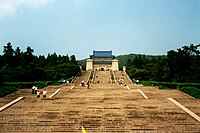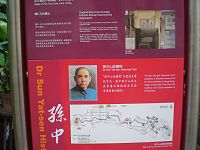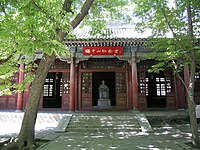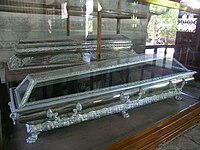Sun Yat-sen
Sun Yat-sen | |
|---|---|
孫中山 | |
Premier of the Kuomintang | |
| In office 10 October 1919 – 12 March 1925 | |
| Preceded by | Office established |
| Succeeded by | Zhang Renjie (as Chairman) |
| Personal details | |
| Born | Sun Te-ming (孫德明) 12 November 1866 Cuiheng Village, Hsiangshan County, Kwangtung Province, Qing Empire. |
| Died | 12 March 1925 (aged 58) Peking Union Medical College Hospital, Beijing, Republic of China |
| Resting place | Sun Yat-sen Mausoleum |
| Political party | Kuomintang |
| Other political affiliations |
|
| Spouses | |
| Domestic partners |
|
| Children | 4, including University of Hong Kong (MD) |
| Occupation | Politician, writer, physician |
| Signature (Chinese) |  |
| Signature | |
| Military service | |
| Branch/service | Republic of China Army |
| Years of service | 1917–1925 |
| Rank | Grand marshal |
| Battles/wars |
|
| Chinese name | |
Hanyu Pinyin | Sūn Démíng |
| Bopomofo | ㄙㄨㄣ ㄉㄜˊ ㄇㄧㄥˊ |
| Wade–Giles | Sun1 Te2-ming2 |
| Tongyong Pinyin | Sun Dé-míng |
| IPA | [swə́n tɤ̌.mǐŋ] |
| Yue: Cantonese | |
| Yale Romanization | Syūn Dāk-mìng |
| Jyutping | syun1 dak1 ming4 |
| IPA | [syːn˥ tɐk̚˥ meŋ˩] |
| Transcriptions | |
|---|---|
| Revised Hepburn | sonbun |
| Kunrei-shiki | sonbun |
Sun Yat-sen
Educated
Sun's chief legacy is his political philosophy known as the Three Principles of the People: Mínzú (民族主義; Mínzúzhǔyì) or nationalism (independence from foreign domination), Mínquán (民權主義; Mínquánzhǔyì) or "rights of the people" (also translated as "democracy"), and Mínshēng (民生主義; Mínshēngzhǔyì) or people's livelihood (sometimes translated as "communitarianism" or "welfarism").[7][8][9]
Names

Sun's
Early years
Birthplace and early life
Sun Te-ming was born on 12 November 1866 to Sun Dacheng and
Education
At the age of 10, in Hawaii, Sun began his schooling.
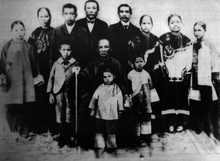
During his stay in Honolulu, Sun Yat-sen went to
When he returned to China in 1883 at age 17, Sun met up with his childhood friend Lu Haodong again at Beijidian (北極殿), a temple in Cuiheng.
In 1886, Sun studied medicine at the
Religious views and Christian baptism
In the early 1880s, Sun Mei had sent his brother to ʻIolani School, which was under the supervision of the
Sun was later
Becoming a revolutionary
Four Bandits
During the Qing-dynasty rebellion around 1888, Sun was in Hong Kong with a group of revolutionary thinkers, nicknamed the
From Furen Literary Society to Revive China Society
In 1891, Sun met revolutionary friends in Hong Kong including Yeung Ku-wan who was the leader and founder of the Furen Literary Society.[40] The group was spreading the idea of overthrowing the Qing. In 1894, Sun wrote an 8,000-character petition to Qing Viceroy Li Hongzhang presenting his ideas for modernizing China.[41][42][43] He traveled to Tianjin to personally present the petition to Li but was not granted an audience.[44] After that experience, Sun turned irrevocably toward revolution. He left China for Hawaii and founded the Revive China Society, which was committed to revolutionizing China's prosperity. It was the first Chinese nationalist revolutionary society.[45]: 31 Members were drawn mainly from Chinese expatriates, especially from the lower social classes. The same month in 1894, the Furen Literary Society was merged with the Hong Kong chapter of the Revive China Society.[40] Thereafter, Sun became the secretary of the newly merged Revive China Society, which Yeung Ku-wan headed as president.[46] They disguised their activities in Hong Kong under the running of a business under the name "Kuen Hang Club"[47]: 90 (乾亨行).[48]
Heaven and Earth Society and overseas travels to seek financial support
A "Heaven and Earth Society" sect known as
First Sino-Japanese War
In 1895, China suffered a serious defeat during the
First uprising and exile
First Guangzhou Uprising


In the second year of the establishment of the Revive China Society, on 26 October 1895, the group planned and launched the
Exile in Japan
While in exile in
Sun traveled by way of
During the Philippine Revolution and the Philippine–American War, Sun helped Ponce procure weapons that had been salvaged from the Imperial Japanese Army and ship the weapons to the Philippines. By helping the Philippine Republic, Sun hoped that the Filipinos would win their independence so that he could use its islands as a staging point of another revolution. However, as the war ended in July 1902, the United States emerged victorious from a bitter three-year war against the Republic. Therefore, the Filipino dream of independence vanished with Sun's hopes of allying with the Philippines in his revolution in China.[58]
From failed uprisings to revolution
Huizhou Uprising
On 22 October 1900, Sun ordered the launch of the
Getting support from Siamese Chinese
In 1903, Sun made a secret trip to
Sun's speech on Yaowarat Road was commemorated by the street later being named "Sun Yat Sen Street" or "Soi Sun Yat Sen" (Thai: ซอยซุนยัตเซ็น) in his honour.[65]
Getting support from American Chinese
According to Lee Yun-ping, chairman of the Chinese historical society, Sun needed a certificate to enter the United States since the
In March 1904, while residing in Kula, Maui, Sun Yat-sen obtained a Certificate of Hawaiian Birth, issued by the Territory of Hawaii, stating that "he was born in the Hawaiian Islands on the 24th day of November, A.D. 1870."[67][68] He renounced it after it served its purpose to circumvent the Chinese Exclusion Act.[68] Official files of the United States show that Sun had United States nationality, moved to China with his family at age 4, and returned to Hawaii 10 years later.[69]
On 6 April 1904, on his first attempt to enter the United States, Sun Yat-sen landed in
Unifying forces of Tongmenghui in Tokyo

In 1904, Sun Yat-sen came about with the goal "to expel the
On 20 August 1905, Sun joined forces with revolutionary Chinese students studying in Tokyo to form the unified group Tongmenghui (United League), which sponsored uprisings in China.[70][71] By 1906 the number of Tongmenghui members reached 963.[70]
Getting support from Malayan Chinese
Sun's notability and popularity extended beyond the
After founding the Tongmenghui, Sun advocated the establishment of the Chong Shing Yit Pao as the alliance's mouthpiece to promote revolutionary ideas. Later, he initiated the establishment of reading clubs across Singapore and Malaysia to disseminate revolutionary ideas by the lower class through public readings of newspaper stories. The United Chinese Library, founded on 8 August 1910, was one such reading club, first set up at leased property on the second floor of the Wan He Salt Traders in North Boat Quay.[75][citation needed]
The first actual United Chinese Library building was built between 1908 and 1911 below Fort Canning, on 51 Armenian Street, commenced operations in 1912. The library was set up as a part of the 50 reading rooms by the Chinese republicans to serve as an information station and liaison point for the revolutionaries. In 1987, the library was moved to its present site at Cantonment Road.
Uprisings
On 1 December 1907, Sun led the
Anti-Sun factionalism
Because of the failures, Sun's leadership was challenged by elements from within the Tongmenghui who wished to remove him as leader. In Tokyo, members from the recently merged
The revolutionaries were polarized and split between pro-Sun and anti-Sun camps.[73] Sun publicly fought off comments about how he had something to gain financially from the revolution.[73] However, by 19 July 1910, the Tongmenghui headquarters had to relocate from Singapore to Penang to reduce the anti-Sun activities.[73] It was also in Penang that Sun and his supporters would launch the first Chinese "daily" newspaper, the Kwong Wah Yit Poh, in December 1910.[76]
1911 revolution

To sponsor more uprisings, Sun made a personal plea for financial aid at the
On 27 April 1911, the revolutionary Huang Xing led the Yellow Flower Mound Uprising against the Qing. The revolt failed and ended in disaster. The bodies of only 72 revolutionaries were identified of the 86 that were found.[82] The revolutionaries are remembered as martyrs.[82]
On 10 October 1911, the military
Republic of China with multiple governments
Provisional government
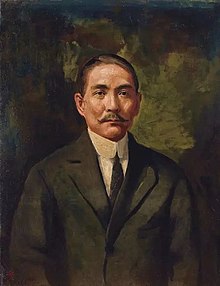
On 29 December 1911, a meeting of representatives from provinces in Nanjing elected Sun as the
Beiyang government
Yuan Shikai, who was in control of the Beiyang Army, had been promised the position of president of the Republic of China if he could get the Qing court to abdicate.[87] On 12 February 1912, the Emperor did abdicate the throne.[86] Sun stepped down as president, and Yuan became the new provisional president in Beijing on 10 March 1912.[87] The provisional government did not have any military forces of its own. Its control over elements of the new army that had mutinied was limited, and significant forces still had not declared against the Qing.
Sun Yat-sen sent telegrams to the leaders of all provinces to request them to elect and to establish the
New Nationalist party in 1912, failed Second Revolution and new exile
The Tongmenghui member
Warlords chaos
In 1915, Yuan proclaimed the
Alliance with Communist Party and Northern Expedition
Guangzhou militarist government
China had become divided among regional military leaders. Sun saw the danger and returned to China in 1916 to advocate
First United Front

Sun was now convinced that the only hope for a unified China lay in a military conquest from his base in the south, followed by a period of
With the Soviets' help, Sun was able to develop the military power needed for the
Financial concerns
In 1924 Sun appointed his brother-in-law
Final speeches

In February 1923, Sun made a presentation to the
On 10 November 1924, Sun traveled north to
Illness and death
For many years, it was popularly believed that Sun died of
His body then was preserved in
In 1926, construction began on a majestic mausoleum at the foot of Purple Mountain in Nanjing, which was completed in the spring of 1929. On 1 June 1929, Sun's remains were moved from Beijing and interred in the Sun Yat-sen Mausoleum.
By pure chance, in May 2016, an American pathologist, Rolf F. Barth, was visiting the Sun Yat-sen Memorial Hall in Guangzhou when he noticed a faded copy of the original autopsy report on display. The autopsy was performed immediately after Sun's death by James Cash, a pathologist at PUMCH. Based on a tissue sample, Cash concluded that the cause of death was an adenocarcinoma in the gallbladder that had metastasized to the liver. In modern China, liver cancer is far more common than gallbladder cancer. Although the incidence rates for either one in 1925 are not known, if one assumes that they were similar at the time, the original diagnosis by Taylor was a reasonable conclusion. From the time of Sun's death to the appearance of Barth's report[111] in the Chinese Journal of Cancer in September 2016, Sun's true cause of death was not reported in any English-language publication. Even in Chinese-language sources, it appeared in only one non-medical online report in 2013.[111][119]
Legacy
Power struggle
After Sun's death, a power struggle between his young protégé
Personality cult
A
The Kuomintang's constitution designated Sun as the party president. After his death, the Kuomintang opted to keep that language in its constitution to honor his memory forever. The party has since been headed by a director-general (1927–1975) and a chairman (since 1975), who discharge the functions of the president.[citation needed]
Though took a stance against idolatry in life, Sun sometimes became worshiped as a god among people. For example, a KMT committee member Hsieh Kun-hong controversially referred to Sun as having "become immortal" after death under the posthumous name of "Great Merciful True Monarch" (Chinese: 偉慈真君) in 2021. Sun is already worshipped in the syncretic Vietnamese religion of Caodaism.[123]
Father of the Nation

Sun Yat-sen remains unique among 20th-century Chinese leaders for having a high reputation in both
Forerunner of revolution
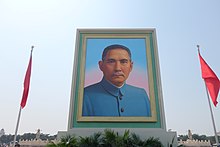
In Mainland China, Sun is seen as a Chinese nationalist, a proto-socialist, and the first president of a Republican China and is highly regarded as the Forerunner of the Revolution (革命先行者).
In 1956, Mao Zedong said, "Let us pay tribute to our great revolutionary forerunner, Dr. Sun Yat-sen!... he bequeathed to us much that is useful in the sphere of political thought."[125][126]
New Three Principles of the People
Sun's Three Principles of the People has been reinterpreted by the Chinese Communist Party to argue that communism is a necessary conclusion of them and thus provide legitimacy for the government. This reinterpretation of the Three Principles of the People is commonly referred to as the New Three Principles of the People (Chinese: 新三民主義, also translated as Neo-tridemism), a word coined by Mao's 1940 essay On New Democracy in which he argued that the Communist Party is a better enforcer of the Three Principles of the People compared to the bourgeois Kuomintang and that the new three principles are about allying with the communists and the Russians (Soviets) and supporting the peasants and the workers.[127] Proponents of the New Three Principles of the People claim that Sun's book Three Principles of the People acknowledges that the principles of welfare is inherently socialistic and communistic.[128]
During the 90th anniversary of the Xinhai Revolution in 2001, former CCP General Secretary Jiang Zemin claimed that Sun supposedly advocated for the "New Three Principles of the People."[129][130] In 2001, Sun's granddaughter Lily Sun said that the Chinese Communists were distorting Sun's legacy. She again voiced her displeasure in 2002 in a private letter to Jiang about the distortion of history.[129] In 2008 Jiang Zemin was willing to offer US$10 million to sponsor a Xinhai Revolution anniversary celebration event. According to Ming Pao, she did not take the money because then she would not "have the freedom to properly communicate the Revolution."[129]
KMT emblem removal case
In 1981, Lily Sun took a trip to Sun Yat-sen Mausoleum in Nanjing. The emblem of the KMT had been removed from the top of his sacrificial hall at the time of her visit but was later restored. On another visit in May 2011, she was surprised to find the four-character "General Rules of Meetings" (會議通則), a document that Sun wrote in reference to Robert's Rules of Order had been removed from a stone carving.[129]
Founding father of the nation debate
In 1940, the Republic of China (ROC) government had bestowed the title of "father of the nation" on Sun. However, after 1949, as a result of the Chiang regime's arrival in Taiwan, his "father of the nation" designation continued only in Taiwan.[131]
Sun visited Taiwan briefly on only three occasions (in 1900, 1913, and 1918) or four by counting 1924, when his boat had stopped in Keelung Harbor, but he did not disembark.[131]
In November 2004, the Taiwanese Ministry of Education proposed that Sun was not the father of Taiwan. Instead, Sun was a foreigner from mainland China.[132] Taiwanese Education Minister Tu Cheng-sheng and the Examination Yuan member Lin Yu-ti, both of whom supported the proposal, had their portraits pelted with eggs in protest.[133] At a Sun Yat-sen statue in Kaohsiung, a 70-year-old retired soldier of the Republic of China committed suicide on Sun's birthday, 12 November, to protest the ministry's proposal.[132][133]
Views
| Part of a series on |
| Three Principles of the People |
|---|
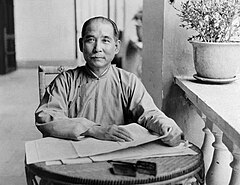 |
|
Economic development
Sun Yat-sen spent years in Hawaii as a student in the late 1870s and early 1880s and was highly impressed with the economic development that he saw there. He used the Kingdom of Hawaii as a model to develop his vision of a technologically modern, politically independent, actively
His key proposal was socialism. He proposed:
- The State will take over all the large enterprises; we shall encourage and protect enterprises which may reasonably be entrusted to the people; the nation will possess equality with other nations; every Chinese will be equal to every other Chinese both politically and in his opportunities of economic advancement.[136]
He also proposed, "If we use existing foreign capital to build up a future communist society in China, half the work will bring double the results."[137][138][139] He also said, "It is my idea to make capitalism create socialism in China."[140][141]
Sun promoted the ideas of the economist Henry George and was influenced by Georgist ideas on land ownership and a land value tax.[142][143]
Culture
Sun supported
Pan-Asianism
Sun was a proponent of Pan-Asianism. He said that Asia was the "cradle of the world's oldest civilisation" and that "even the ancient civilisations of the West, of Greece and Rome, had their origins on Asiatic soil." He thought that it was only in recent times that Asians "gradually degenerated and become weak."[145] For Sun, "Pan-Asianism is based on the principle of the Rule of Right, and justifies the avenging of wrongs done to others." He advocated overthrowing the Western "Rule of Might" and "seeking a civilisation of peace and equality and the emancipation of all races."[146]
Family
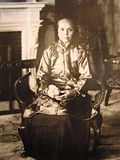


Sun Yat-sen was born to Sun Dacheng (孫達成) and his wife, Lady Yang (楊氏) on 12 November 1866.[147] At the time, his father was 53, and his mother was 38 years old. He had an older brother, Sun Dezhang (孫德彰), and an older sister, Sun Jinxing (孫金星), who died at the early age of 4. Another older brother, Sun Deyou (孫德祐), died at the age of 6. He also had an older sister, Sun Miaoqian (孫妙茜), and a younger sister, Sun Qiuqi (孫秋綺).[31]
At age 20, Sun had an
Sun's first
During Sun's exile in Japan, he had relationships with two Japanese women: the 15-year-old Haru Asada, whom he took as a concubine up to her death in 1902, and another 15-year-old schoolgirl, Kaoru Otsuki, whom Sun married in 1905 and abandoned the next year while she was pregnant.[150] Otsuki later had their daughter, Fumiko, adopted by the Miyagawa family in Yokohama, who did not discover her parentage until 1951,[150] 26 years after Sun's death.
On 25 October 1915 in Japan, Sun married
Soong Ching-Ling's sister, Soong Mei-ling, later married Chiang Kai-shek.
Cultural references
Memorials and structures in Asia

In most major
Other references to Sun include the
In Russia, a village in
In George Town, Penang, Malaysia, the Penang Philomatic Union had its premises at 120 Armenian Street in 1910, while Sun spent more than four months in Penang and convened the historic "Penang Conference" to launch the fundraising campaign for the Huanghuagang Uprising and founded the Kwong Wah Yit Poh. The house, which has been preserved as the Sun Yat-sen Museum (formerly called the Sun Yat Sen Penang Base), was visited by President-designate Hu Jintao in 2002. The Penang Philomatic Union subsequently moved to a bungalow at 65 Macalister Road, which has been preserved as the Sun Yat-sen Memorial Centre Penang.
As a dedication, the 1966 Chinese Cultural Renaissance was launched on Sun's birthday on 12 November.[156]
The Nanyang Wan Qing Yuan in Singapore have since been preserved and renamed as the Sun Yat Sen Nanyang Memorial Hall.[74] A Sun Yat-sen heritage trail was also launched on 20 November 2010 in Penang.[157]
Sun's Hawaiian birth certificate, which claimed that he was not born in China but in the United States, was on public display at the
A street in Medan, Indonesia, is named "Jalan Sun Yat-Sen" in honor of him.[159]
A street named "Tôn Dật Tiên" (the Sino-Vietnamese name for Sun Yat-Sen) is located in Phú Mỹ Hưng Urban Area, Ho Chi Minh City, Vietnam.
The "Trail of Dr. Sun Yat Sen and His Comrades in Ipoh"[160] was established in 2019, based on the book "Road to Revolution: Dr. Sun Yat Sen and His Comrades in Ipoh."[161]
Gallery
-
Mausoleum of Sun Yat-sen, Nanjing.
-
Sun Yat-sen Memorial Hall, Taipei.
-
Sun Yat-sen Memorial Centre, George Town, Penang, Malaysia.
-
A marker on theSun Yat-sen Historical Trail on Hong Kong Island.
-
Sun Yat-sen Memorial Hall at Temple of Azure Clouds in Beijing, China.
-
Coffin (unused) for Sun Yat-sen, gifted by theСССР, in Temple of Azure Clouds.
-
Bronze statue in the Kang Le Yuan Garden at the South Guangzhou Campus ofUmeya Shokichi at Guangzhou National Sun Yat-sen University Shipai Campus, which is now home to the South China University of Technology.
Memorials and structures outside Asia
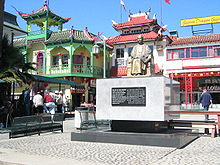

In
In late 2011, the Chinese Youth Society of

In 1993,
In 2019, a statue of Dr. Sun Yat-sen by Lu Chun-Hsiung and Michael Kang was permanently installed in the northern plaza of Manhattan's Columbus Park.[169][170]
In popular culture
Opera
Television series and films
Sun Yat-sen's life is portrayed in various films, mainly The Soong Sisters and Road to Dawn. A fictionalized assassination attempt on his life was featured in Bodyguards and Assassins. He is also portrayed during his struggle to overthrow the Qing dynasty in Once Upon a Time in China II. The television series Towards the Republic features Ma Shaohua as Sun. In 1911, a film commemoration of the 100th anniversary of the Chinese Revolution, Winston Chao played Sun.[173] In Space: Above and Beyond, one of the starships of the China Navy is named the Sun Yat-sen.[174]
Performances
In 2010, the theatrical play Yellow Flower on Slopes (斜路黃花) was created and performed.[175]
In 2011, the Mandopop group Zhongsan Road 100 (中山路100號) was known for singing the song "Our Father of the Nation" (我們國父).[176]
Works
- Kidnapped in London (1897)
- The Outline of National Reconstruction/Chien Kuo Ta Kang (1918)
- The Fundamentals of National Reconstruction/Jianguo fanglue (1924)
- The Principle of Nationalism (1953)
See also
- Chiang Kai-shek
- Chiang Ching-kuo
- History of the Republic of China
- Politics of the Republic of China
- Sun Yat-sen Museum Penang
- United States Constitution and worldwide influence
- Zhongshan suit
- Kuomintang
- Three Principles of the People
Notes
- ^ In this Chinese name, the family name is Sun.
- ^ Also known by several other names.Sun's most common names in English and Chinese respectively are listed, but his common English name was originally derived from one of his less common Chinese names, traditional Chinese: 孫逸仙; simplified Chinese: 孙逸仙; pinyin: Sūn Yìxiān; Jyutping: syun1 jat6 sin1.
- British Foreign Office persuaded the Legation to release Sun.[54]
References
- ^ "中國國民黨大事記". 中國國民黨全球資訊網 [KMT Global Info Web] (in Chinese (Taiwan)). Archived from the original on 2 August 2009. Retrieved 26 July 2009.
- ^ Steinberg, Jessica (10 February 2021). "China's century-old support for Zionism surfaces in letter". The Times of Israel. Retrieved 11 August 2022.
- ^ Singtaodaily. Saturday edition. 23 October 2010. 特別策劃 section A18. Sun Yat-sen Xinhai revolution 100th anniversary edition 民國之父.
- ^ National Dr. Sun Yat-sen Memorial Hall. Archived from the originalon 16 April 2014. Retrieved 12 March 2014.
- ^ ISBN 978-9024705528. pp. 92, 106.
- PMID 27586157.
- Encyclopedia Britannica. Retrieved 15 May 2017.
- .
- ^ Sun, Yat-sen (3 August 1924). "三民主義:民生主義 第一講 [Three Principles of the People: People's living, Lecture 1]". 《國父全集》 [Complete collection of the National Father's scripts] (in Traditional Chinese). pp. 0129–0145. Retrieved 30 December 2019 – via 中山學術資料庫系統.
我們國民黨提倡民生主義,已經有了二十多年,不講社會主義,祇講民生主義。社會主義和民生主義的範圍是甚麼關係呢?近來美國有一位馬克思的信徒威廉氏,深究馬克思的主義,見得自己同門互相紛爭,一定是馬克思學說還有不充分的地方,所以他便發表意見,說馬克思以物質為歷史的重心是不對的,社會問題才是歷史的重心;而社會問題中又以生存為重心,那才是合理。民生問題就是生存問題......
- ^ ISBN 978-9862217078.
- ISBN 978-9570521566.
- ^ ISBN 978-9571142685.
- ^ 门杰丹 (4 December 2003). 浓浓乡情系中原—访孙中山先生孙女孙穗芳博士 [Central Plains Nostalgia-Interview with Dr. Sun Suifang, granddaughter of Sun Yat-sen]. China News (in Chinese). Archived from the original on 8 July 2011. Translate this Chinese article to English
- ^ Bohr, P. Richard (2009). "Did the Hakka Save China? Ethnicity, Identity, and Minority Status in China's Modern Transformation". Headwaters. 26 (3): 16.
- ISBN 978-0804740111.
- ^ Star-Advertiser. Honolulu. Retrieved 21 August 2017.
- ^ a b c d KHON web staff (3 June 2013). "Chinese government officials attend Sun Mei statue unveiling on Maui". KHON2. Honolulu. Archived from the original on 22 August 2017. Retrieved 21 August 2017.
- ^ a b c d "Sun Yat-sen Memorial Park". Hawaii Guide. Retrieved 21 August 2017.
- ^ a b c d "Sun Yet Sen Park". County of Maui. Retrieved 21 August 2017.[permanent dead link]
- S2CID 157738017.
- ^ "Dr. Sun Yat-Sen (class of 1882)". ʻIolani School website. Archived from the original on 20 July 2011.
- ^ Brannon, John (16 August 2007). "Chinatown park, statue honor Sun Yat-sen". Honolulu Star-Bulletin. Archived from the original on 4 October 2012. Retrieved 17 August 2007.
Sun graduated from Iolani School in 1882, then attended Oahu College—now known as Punahou School—for one semester.
- ^ 基督教與近代中國革命起源:以孫中山為例. Big5.chinanews.com:89. Archived from the original on 28 October 2011. Retrieved 26 September 2011.
- ^ 歷史與空間:基督教與近代中國革命的起源──以孫中山為例 – 香港文匯報. Paper.wenweipo.com. 2 April 2011. Archived from the original on 27 October 2011. Retrieved 26 September 2011.
- ^ "Central and Western Heritage Trail". Archived from the original on 9 July 2021. Retrieved 6 July 2021.
- ^ "The Diocesan Home and Orphanage". 孫中山史蹟徑. 17 November 2017. Retrieved 6 July 2021.
- ^ 中山史蹟徑一日遊. Lcsd.gov.hk. Archived from the original on 2 November 2011. Retrieved 26 September 2011.
- ^ "The Government Central School". 孫中山史蹟徑. 14 January 2018. Retrieved 6 July 2021.
- ^ a b Yat-sen, Sun. "Chapter I: The Imbroglio". Kidnapped in London.
- ISBN 978-9622096134.
- ^ SingtaoDaily. 28 February 2011. 特別策劃 section A10. "Sun Yat-sen Xinhai revolution 100th anniversary edition".
- ^ South China Morning Post. "Birth of Sun heralds dawn of revolutionary era for China". 11 November 1999.
- ^ "...At present there are some seven members in the interior belonging to our mission, and two here, one I baptized last Sabbath, a young man who is attending the Government Central School. We had a very pleasant communion service yesterday..." – Hager to Clark, 5 May 1884, ABC 16.3.8: South China v.4, no.17, p.3
- ^ "...We had a pleasant communion yesterday and received one Chinaman into the church..." – Hager to Pond, 5 May 1884, ABC 16.3.8: South China v.4, no.18, p.3 postscript
- ^ Rev. C. R. Hager, 'The First Citizen of the Chinese Republic', The Medical Missionary v.22 1913, p.184
- ^ Bergère: 26
- ^ a b Soong, (1997) p. 151-178
- ^ 中西區區議會 [Central & Western District Council] (November 2006), 孫中山先生史蹟徑 [Dr Sun Yat-sen Historical Trail] (PDF), Dr. Sun Yat-sen Museum (in Chinese and English), Hong Kong, China, p. 30, archived from the original (PDF) on 24 February 2012, retrieved 15 September 2012
- ISBN 978-9622095748. p. 183.
- ^ ISBN 978-1920942441. p. 101.
- ISBN 978-0817992811.
- ^ ISBN 9628885286.
- ^ Bergère: 39–40
- ^ Bergère: 40–41
- ISBN 978-0-472-05650-7.
- ^ ISBN 978-9881804167
- ISBN 978-9622093935., founder Tse Tsan-tai's account
- ^ 孫中山第 – 次辭讓總統並非給袁世凱 – 文匯資訊. Info.wenweipo.com. Archived from the original on 22 March 2012. Retrieved 26 September 2011.
- ^ ISBN 978-0-8264-5749-3. p. 209.
- ^ ISBN 978-1412958653. p 168.
- ISBN 978-0791463222. p. 27.
- ^ Maui Nō Ka ʻOi Magazine. Retrieved 2 February 2017.
- ^ "Sun Yat-sen | Chinese leader". Encyclopedia Britannica. Retrieved 31 March 2018.
- ^ Wong, J.Y. (1986). The Origins of a Heroic Image: SunYat Sen in London, 1896–1987. Hong Kong: Oxford University Press.
as summarized in
Clark, David J.; Gerald McCoy (2000). The Most Fundamental Legal Right: Habeas Corpus in the Commonwealth. Oxford: Oxford University Press. p. 162.ISBN 978-0198265849. - ^ Cantlie, James (1913). Sun Yat Sen and the Awakening of China. London: Jarrold & Sons.
- ^ "JapanFocus". Old.japanfocus.org. Archived from the original on 16 March 2012. Retrieved 26 September 2011.
- ^ Thornber, Karen Laura. (2009). Empire of Texts in Motion: Chinese, Korean, and Taiwanese Transculturations of Japanese Literature. Harvard University Press. p. 404.
- ^ Ocampo, Ambeth (2010). Looking Back 2. Pasig: Anvil Publishing. pp. 8–11.
- ISBN 978-0810849303. Chronology section.
- ^ Bergère: 86
- ISBN 978-9571136752.
- ISBN 978-0674017535. p. 651.
- ^ 三十三年落花夢 Taiwan Ebook, National Central Library
- ^ Eiji Murashima. "The Origins of Chinese Nationalism in Thailand" (PDF). Journal of Asia-Pacific Studies (Waseda University). Archived from the original (PDF) on 30 March 2017. Retrieved 30 March 2017.
- ^ Eric Lim. "Soi Sun Yat Sen the legacy of a revolutionary". Tour Bangkok Legacies. Retrieved 30 March 2017.
- ^ a b c 孫中山思想 3學者演說精采. World journal. 4 March 2011. Archived from the original on 13 May 2013. Retrieved 26 September 2011.
- ^ "Sun Yat-sen: Certification of Live Birth in Hawaii". San Francisco, CA, US: Scribd. Retrieved 15 September 2012.
- ^ a b Smyser, A.A. (2000). Sun Yat-sen's strong links to Hawaii. Honolulu Star Bulletin. "Sun renounced it in due course. It did, however, help him circumvent the Chinese Exclusion Act of 1882, which became applicable when Hawaii was annexed to the United States in 1898."
- ^ Department of Justice. Immigration and Naturalization Service. San Francisco District Office. "Immigration Arrival Investigation case file for SunYat Sen, 1904–1925" (PDF). Records of the Immigration and Naturalization Service, 1787–2004 ]. Washington, DC, US: National Archives and Records Administration. pp. 92–152. Immigration Arrival Investigation case file for SunYat Sen, 1904–1925 at the National Archives and Records Administration. Archived from the original (PDF) on 16 October 2013. Retrieved 15 September 2012. Note that one immigration official recorded that Sun was born in Kula, a district of Maui, Hawaii.
- ^ ISBN 978-9622019874. p. 468.
- ^ "Internal Threats – The Manchu Qing Dynasty (1644–1911) – Imperial China – History – China – Asia". Countriesquest.com. Retrieved 26 September 2011.
- ISBN 978-9839886009.
- ^ ISBN 978-9812790477. pp. 182–187.
- ^ a b "Sun Yat Sen Nanyang Memorial Hall". Wanqingyuan.org.sg. Archived from the original on 20 August 2013. Retrieved 7 May 2015.
- ^ "United Chinese Library". Roots. National Heritage Board. Archived from the original on 3 December 2019. Retrieved 15 September 2019.
- ^ ISBN 978-9834283483.
- ISBN 978-0062067258.
- ^ Nanyang Zonghui bao. The Union Times paper. 11 November 1909 p2.
- ^ a b c Bergère: 188
- ISBN 978-9810782092.
- ^ Khoo & Lubis, Salma Nassution & Abdur-Razzaq (2005). Kinta Valley: Pioneering Malaysia's Modern Development. Areca Books. p. 231.
- ^ ISBN 9628885286. pp. 195–198.
- ISBN 978-0595482368.
- ^ Bergère: 210
- ISBN 978-0615244792.
- ^ ISBN 978-0742553149. p. 87.
- ^ ISBN 978-0521442282). pp. 153–154.
- ^ Bergère: 226
- ^ ISBN 978-0804705516. pp. 83–91.
- ISBN 978-0521235419), p. 228.
- ^ Altman, Albert A., and Harold Z. Schiffrin. "Sun Yat-Sen and the Japanese: 1914–16." Modern Asian Studies, vol. 6, no. 4, 1972, pp. 385–400. JSTOR, www.jstor.org/stable/311539
- ^ South China Morning post. Sun Yat-sen's durable and malleable legacy. 26 April 2011.
- ^ Thampi, Madhavi. India and China in the Colonial World. Taylor & Francis. p. 229.
- ^ South China morning post. 1913–1922. 9 November 2003.
- ^ a b Bergère & Lloyd: 273
- ISBN 978-0674003682. p. 59.
- ISBN 978-1-350-23394-2.
- ISBN 978-1443725217. Retrieved 28 June 2010.
- ^ Ross, Harold Wallace; White, Katharine Sergeant Angell (1980). Great Soviet Encyclopedia. p. 237. Retrieved 28 June 2010.
- ^ Aleksandr Mikhaĭlovich Prokhorov (1982). Great Soviet encyclopedia, Volume 25. Macmillan. Retrieved 28 June 2010.
- ISBN 978-1609574567. Retrieved 28 June 2010.
- ^ M.N. Roy's Mission to China. University of California Press. pp. 19–20.
- ISBN 978-0810849303. p. 251.
- ISBN 978-0-393-30780-1. p. 345.
- ISBN 978-0765610034. p. 165.
- ISBN 0199282714
- ISBN 0674017013
- ISBN 978-1604976601. p. 156.
- ^ 马福祥,临夏回族自治州马福祥,马福祥介绍 – 走遍中国. www.elycn.com. Archived from the original on 13 May 2013. Retrieved 23 June 2017.
- ISBN 978-0804769228.
- ^ PMID 27586157.
- ^ a b "Dr. Sun Yat-sen Dies in Peking". The New York Times. 12 March 1925. Retrieved 28 December 2017.
- ^ "Lost Leader". Time. 23 March 1925. Archived from the original on 4 May 2008. Retrieved 3 August 2008.
A year ago his death was prematurely announced; but it was not until last January that he was taken to the Rockefeller Hospital at Peking and declared to be in the advanced stages of cancer of the liver.
- ^ Sharman, L. (1968) [1934]. Sun Yat-sen: His life and times. Stanford, California: Stanford University Press. pp. 305–306, 310.
- ^ 國父遺囑 [Founding Father's Will]. Vincent's Calligraphy. Archived from the original on 7 August 2016. Retrieved 14 May 2016.
- ISBN 978-0804776882.
- ]
- ^ a b "The Sydney Morning Herald. Sun Yat-Sen's Coffin. Soviet's Tawdry Gift". National Library of Australia. 25 April 1925. Retrieved 6 July 2023.
- ^ "Clinical record copies from the Peking Union Medical College Hospital decrypt the real cause of death of Sun Yat-sen". Nanfang Daily (in Chinese). 11 November 2013. Archived from the original on 7 November 2017. Retrieved 28 December 2017.
- ^ "她是中華民國國父的妻子 但是全力支持中國共產黨 -- 上報 / 生活".
- ISBN 0742511448. Retrieved 28 June 2010.
- ISBN 978-0415368353. Retrieved 28 June 2010.
- ^ "KMT Divided Over God-Status of Founder Sun Yat-sen". The News Lens. 28 April 2021.
- ISBN 978-0742539440. p. 269.
- ^ Selected Works of Mao Tse-Tung: Volume 5, Volume 5. 2014. p. 333.
- ^ Dimitrakis, Panagiotis (2017). The Secret War for China: Espionage, Revolution and the Rise of Mao. Bloomsbury Publishing. p. 4.
- ^ Mao, Zedong. "On New Democracy". www.marxists.org. Retrieved 7 May 2022.
- ^ . (in Chinese) – via Wikisource.
- ^ a b c d Kenneth Tan (3 October 2011). "Granddaughter of Sun Yat-Sen accuses China of distorting his legacy". Shanghaiist. Archived from the original on 11 October 2011. Retrieved 8 October 2011.
- ^ 国父孙女轰中共扭曲三民主义愚民_多维新闻网 (in Chinese). China.dwnews.com. 1 October 2011. Archived from the original on 7 October 2011. Retrieved 8 October 2011.
- ^ a b "Is Sun Yat-sen the 'founding father'?". Taipei Times. 29 February 2016. Archived from the original on 29 December 2019. Retrieved 9 November 2022.
- ^ a b 人民网—孙中山遭辱骂 "台独"想搞"台湾国父". People's Daily. Archived from the original on 13 May 2013. Retrieved 12 October 2011.
- ^ a b Chiu Hei-yuan (5 October 2011). "History should be based on facts". Taipei Times. p. 8.
- ^ Lorenz Gonschor, "Revisiting the Hawaiian Influence on the Political Thought of Sun Yat-sen." Journal of Pacific History 52.1 (2017): 52–67.
- ^ Eric Helleiner, "Sun Yat-sen as a Pioneer of International Development." History of Political Economy 50.S1 (2018): 76–93.
- ^ Stephen Shen, and Robert Payne, Sun Yat-Sen: A Portrait (1946) p 182
- ^ Unger, Jonathan (2015). Using the Past to Serve the Present: Historiography and Politics in Contemporary China. Routledge. p. 248.
- S2CID 155947428.
- ^ The Far East in the Modern World. Dryden Press. 1975. p. 384.
- ^ Westad, Odd Arne (2012). Restless Empire: China and the World Since 1750. Random House. p. 155.
- ^ France-Malone, Derek (2011). Political Dissent: A Global Reader: Modern Sources. Lexington Books. p. 175.
- ^ Sun Yat-sen. Stanford University Press. 1998. p. 168.
- ^ Peng, Chun (2018). Rural Land Takings Law in Modern China: Origin and Evolution. Cambridge University Press. p. 135.
- ^ OCLC 1366057905.
- ^ Pan-Asianism A Documentary History, 1920–Present. Rowman & Littlefield Publishers. 2011. p. 78.
- ^ Pan-Asianism A Documentary History, 1920–Present. Rowman & Littlefield Publishers. 2011. p. 85.
- ^ 孫中山學術研究資訊網 – 國父的家世與求學 [Dr. Sun Yat-sen's family background and schooling]. [sun.yatsen.gov.tw/ sun.yatsen.gov.tw] (in Chinese). 16 November 2005. Archived from the original on 24 September 2011. Retrieved 2 October 2011.
- ^ "Sun Yat-sen's descendant wants to see unified China". News.xinhuanet.com. 11 September 2011. Archived from the original on 30 October 2014. Retrieved 2 October 2011.
- ^ "Antong Cafe, The Oldest Coffee Mill in Malaysia". Archived from the original on 12 January 2018. Retrieved 12 January 2018.
- ^ a b Correspondent, Our. "Japan-Revolution". www.asiasentinel.com. Retrieved 31 January 2022.
- ^ Isaac F. Marcosson, Turbulent Years (1938), p.249
- ^ "Россия, Астраханская область, Астрахань, улица Сун Ят-Сена". mapdata.ru. Retrieved 11 October 2020.
- ^ "Россия, Башкортостан, Уфа, улица Сун-Ят-Сена". mapdata.ru. Retrieved 11 October 2020.
- ^ "Россия, Якутия, Алданский улус, Алдан, улица Сунь-ят-Сена". mapdata.ru. Retrieved 11 October 2020.
- ^ "ЮБИЛЕЙНЫЕ ПЕРЕИМЕНОВАНИЯ". omsknews.ru. 16 May 2005. Retrieved 11 October 2020.
- ISBN 0252029739. p. 67.
- ^ "Sun Yet Sen Penang Base – News 17". Sunyatsenpenang.com. 19 November 2010. Retrieved 2 October 2011.[dead link]
- ^ "Sun Yat-sen's US birth certificate to be shown". Taipei Times. 2 October 2011. p. 3. Retrieved 8 October 2011.
- ^ "Google Maps". Retrieved 6 December 2015.
- ^ Kaur, Manjit (2 January 2020). "On the trail of Sun Yat Sen and comrades". The Star.
- ISBN 978-9810782092.
- ^ "Queens Campus". www.youvisit.com. Archived from the original on 18 May 2017. Retrieved 23 June 2017.
- ^ "City to Dedicate Statue and Rename Park to Honor Dr. Sun Yat-Sen". The City and County of Honolulu. 12 November 2007. Archived from the original on 27 October 2011. Retrieved 9 April 2010.
- ^ "Sun Yat-sen". Archived from the original on 20 October 2017. Retrieved 6 December 2015.
- ^ "St. Mary's Square in San Francisco Chinatown – The largest chinatown outside of Asia". Retrieved 6 December 2015.
- ^ "Chinese Youth Society of Melbourne". www.cysm.org. Chinese Youth Society of Melbourne. Archived from the original on 29 July 2012. Retrieved 23 January 2012.
- ^ a b c "Char Asian-Pacific Study Room". Library.kcc.hawaii.edu. 23 June 2009. Archived from the original on 2 April 2012. Retrieved 26 September 2011.
- ^ "Mars Exploration Rover Mission: Press Release Images: Spirit". Marsrover.nasa.gov. Archived from the original on 7 June 2012. Retrieved 2 October 2011.
- ^ Maisel, Todd (12 November 2019). "Chinatown park plaza renamed for Dr. Sun Yat-Sen with bronze statue". www.amny.com. Retrieved 14 November 2019.
- ^ Pereira, Sydney (6 February 2019). "Chinese Revolutionary Honored With LES Statue". Lower East Side-Chinatown, NY Patch. Retrieved 14 November 2019.
- ^ "Opera Dr Sun Yat-sen to stage in Hong Kong". News.xinhuanet.com. 7 September 2011. Archived from the original on 1 November 2014. Retrieved 8 July 2013.
- ^ Gerard Raymond, "Between East and West: An Interview with David Henry Hwang" on slantmagazine.com, 28 October 2011
- ^ "Commemoration of 1911 Revolution mounting in China". News.xinhuanet.com. Archived from the original on 26 November 2013. Retrieved 2 October 2011.
- ^ "Space: Above and Beyond s01e22 Episode Script SS". www.springfieldspringfield.co.uk. Archived from the original on 15 February 2017. Retrieved 15 February 2017.
- ^ 《斜路黃花》向革命者致意 (in Traditional Chinese). Takungpao.com. Retrieved 12 October 2011.[dead link]
- ^ 元智大學管理學院 (in Traditional Chinese). Cm.yzu.edu.tw. Archived from the original on 2 April 2012. Retrieved 26 September 2011.
Further reading
- Bergère, Marie-Claire (2000). Sun Yat-sen. Stanford University Press.
- Buck, Pearl S., The Man Who Changed China: The Story of Sun Yat-sen (1953) online, popular biography by famous writer
- Chen, Stephen, and Robert Payne. Sun Yat Sen A Portrait (1946) online
- Cheng, Chu-yuan ed. Sun Yat-sen's Doctrine In The Modern World (1989)
- D'Elia, Paschal M. Sun Yat-sen. His Life and Its Meaning, a Critical Biography (1936)
- Du, Yue. "Sun Yat-sen as Guofu: Competition over Nationalist Party Orthodoxy in the Second Sino-Japanese War." Modern China 45.2 (2019): 201–235.
- Jansen, Marius B. The Japanese and Sun Yat-sen (1967) online
- Kayloe, Tjio. The Unfinished Revolution: Sun Yat-Sen and the Struggle for Modern China (2017). excerpt
- Khoo, Salma Nasution. Sun Yat Sen in Penang (Areca Books, 2008).
- Lee, Lai To; Lee, Hock Guan, eds. (2011). Sun Yat-Sen, Nanyang and the 1911 Revolution. Institute of Southeast Asian Studies. ISBN 978-9814345460.
- Linebarger, Paul M.A. Political Doctrines Of Sun Yat-sen (1937) online free
- Martin, Bernard. Sun Yat-sen's vision for China (1966)
- Restarick, Henry B., Sun Yat-sen, Liberator of China. (Yale UP, 1931)
- Schiffrin, Harold Z. "The Enigma of Sun Yat-sen" in Mary Wright, ed., China in Revolution: The First Phase 1900-1913 (1968) pp 443–476.
- Schiffrin, Harold Z. Sun Yat-sen: Reluctant Revolutionary (1980)
- Schiffrin, Harold Z. Sun Yat-sen and the origins of the Chinese revolution (1968).
- Shen, Stephen and Robert Payne. Sun Yat-Sen: A Portrait (1946) online free
- Soong, Irma Tam. "Sun Yat-sen's Christian Schooling in Hawai'i." The Hawaiian Journal of History, vol. 31 (1997) online Archived 10 October 2019 at the Wayback Machine
- Wilbur, Clarence Martin. Sun Yat-sen, frustrated patriot (Columbia University Press, 1976), a major scholarly biography online
- Yu, George T. "The 1911 Revolution: Past, Present, and Future", Asian Survey, 31#10 (1991), pp. 895–904, online historiography
External links
- "Sun Yat Sen Nanyang memorial hall". Archived from the original on 20 August 2013. Retrieved 7 May 2015.
- "Doctor Sun Yat Sen memorial hall". Archived from the original on 29 August 2005. Retrieved 1 July 2005.
- ROC Government Biography (in English and Chinese)
- Sun Yat-sen in Hong Kong University of Hong Kong Libraries, Digital Initiatives
- Contemporary views of Sun among overseas Chinese
- Yokohama Overseas Chinese School established by Sun Yat-sen
- National Dr. Sun Yat-sen Memorial Hall Official Website (in English and Chinese)
- Homer Lea Research Center
- Dr. Sun Yat-Sen Foundation of Hawaii A virtual library on Sun in Hawaii including sources for six visits
- Who is Homer Lea? Sun's best friend. He trained Chinese soldiers and prepared the frame work for the 1911 Chinese Revolution.
- Works by Sun Yat-sen at Project Gutenberg
- Works by or about Sun Yat-sen at Internet Archive
- Works by Sun Yat-sen at LibriVox (public domain audiobooks)

- Funeral procession for Sun Yat-sen in Chinatown, Los Angeles at the Los Angeles Times Photographic Archive (Collection 1429). UCLA Library Special Collections, Charles E. Young Research Library, University of California, Los Angeles.

